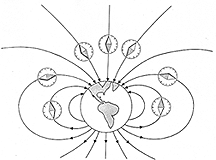Goals: The student will learn here
Terms: Sunspot, magnetic field lines, magnetic fields, sunspot cycle, solar activity, solar flare, magnetic storm, magnetic energy Stories: The discovery of electromagnetism by Oersted and Ampére, the discovery of the sunspot cycle by Heinrich Schwabe and the discovery of solar flares by Richard Carrington. The teacher is advised to read those stories before the class, to help present them to students (students can also be assigned to read the material and make presentations). This material is sufficient for more than one session and the teacher should decide ahead of time, what to include and what to omit. Web pages exist on the original articles by Schwabe and by Carrington, and Oersted's experiment can be easily performed on a tabletop--see end of the above web pageon Oersted and Ampére. For a version performed with a transparent field compass on top of an opaque projector, allowing the entire class to watch it, see here. For a discussion of the causes of the Sun's magnetism see "The Sun's Magnetic Cycle" and the section on the dynamo process which follows it in the same web collection. For more details and for some technical references, see the section "Sunspots", part of a more advanced review. Starting the lesson:(As described here, the teacher would begin the lesson around the above stories of discovery)No area of science draws as much interest as stories of discovery, and of the unusual people who made them. This class has already covered some interesting discoveries. Which of them were associated with the names of... Aristarchus? Erathostenes? Columbus (even if it wasn't a scientific discovery)? Copernicus? Kepler? Newton? Louis Pasteur was a French biochemist in the 19th century, whose many discoveries included a way of preserving food by heating ("pasteurization") and a procedure for saving the lives of people bitten by animals infected with rabies, which up till then meant almost certain death. Commenting on scientific discoveries, Pasteur said "chance favors the prepared mind". Discoveries often depend on luck--but luck is not enough, the mind must be prepared to exploit its opportunity. [a student might prepare a poster with that quote, to hang in class] Today as we discuss magnetism and magnetic phenomena on the Sun, we will discuss three discoveries in which luck had a part--but luck wasn't the only reason. (List on the board--students copy.)
(possible comment: Each discovery occured in a different country!. Science is truly international.) The discovery of the connection between electricity and magnetism What do we know about magnetism of iron magnets?
[Why is plain iron attracted to a magnet? Because when iron is in the region of influence of a magnet--its "magnetic field"--it becomes temporarily magnetic itself, with the pole closest to a pole of the magnet having opposite polarity, causing it to be attracted.] What magnetic phenomena do not involve iron, and why are they called "electromagnetic" phenomena?
Then tell the story of Oersted and Ampére, on "how the connection between electric currents and magnetism was discovered", or else have students who have prepared the story tell the class. (The teacher might also mention that the American Association of Physics Teachers gives each year the "Oersted Award" for an outstanding contribution to the teaching of physics.)
(optional) The magnetic field which satellites observe in space is often different from what one would expect, based on the fields we observe on the ground. The reason is that large electric currents often flow through the space surrounding the Earth, and they contribute their own magnetic fields as well. The currents can flow there, because of the presence of a mixture of free electrons and free positive ions (a "plasma"). What to you think--would such currents tend to spread out to cover as much space as possible, or would they narrow down to string-like filaments? You must give a reason. [If no one answers:"It has to do with the forces between electric currents."]
(This tendency of currents to narrow down has been used to compress laboratory plasmas, where it is named the "pinch effect.") Suppose you had a compass needle able to point in any direction in space, not just horizontally. How would the northward-pointing end of the needle point at
[Note: such needles are available--see end of section S-3, or click here: http://www.cochranes.co.uk/BNRVP30/edu5.htm]
How would such a needle point near a straight wire carrying an electric current? (Neglect the Earth's magnetism)
What are magnetic field lines? Base your definition on the magnetic needle described above.
What is Andre-Marie Ampére remembered for?
[P.S.: He is also remembered as the man who was invited to dinner with Napoleon and forgot to go!] The intensity of the Earth's magnetic field at the magnetic equator is about 30,000 nT (nanotesla) or 0.3 gauss. The field intensity goes down with distance r like 1/r3. If the intensity of the interplanetary magnetic field at the Earth's orbit is 5 nT (a typical value), at what distance--in Earth radii--is this matched by the Earth's field? (Needs calculator capable of extracting cube roots, or raising to the 1/3 power.)
Then go on to the discovery of sunspots. When and how were sunspots discovered?
What did the discoverers see?
How do we know that the Sun rotates around its axis?
What is unusual about the Sun's rotation?
Optional: The teacher may draw a table with the observed latitude dependence of the rotation period (in days) and let students graph it:
|
